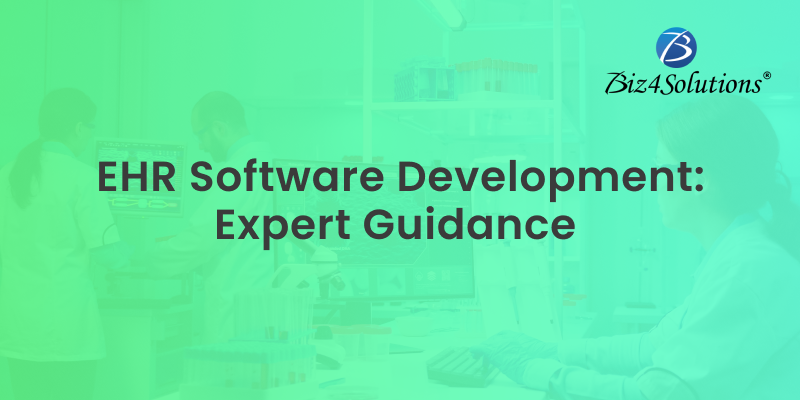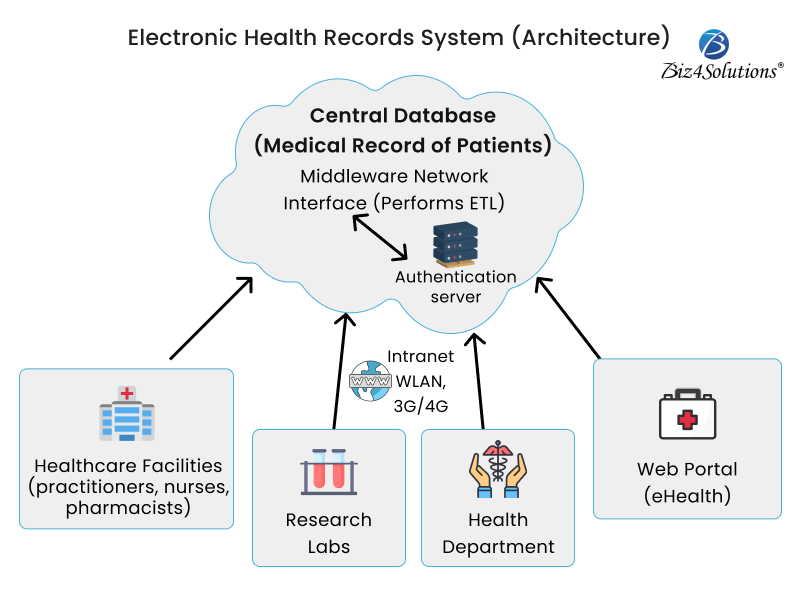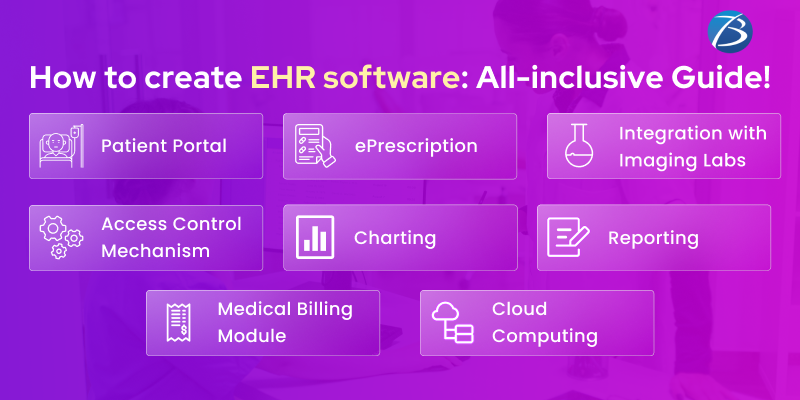
EHR software has become an inseparable part of every modern-day healthcare facility whether it is a big hospital or a small-sized clinic.
Developing a flawless and highly functional EHR is a complex process and involves several steps. Also, you need to pick the right business model and feature set that suits you best. Besides, you need to identify the tech stack and software development tools that best fit into your use case requirements. All the aforementioned aspects also depend on your project's complexity, budget, and resource availability. So, if you are planning to develop an EHR, you need to have a clear idea of the nitty-gritty of EHR development. If you plan to go for off-the-shelf EHR systems; even then you should have a thorough knowledge of the software so that you are able to pick a solution that matches your business objective and operational requirements.
This post provides detailed insights into an EHR solution, the must-have features, and guidance on how to develop it.
What is EHR Software?
EHR (Electronic Health Records) is a digital records system that electronically stores patients’ health information. Authorized users can access this information. This software helps healthcare service providers to capture and store patients’ data including their medical history and information about diagnoses, medications prescribed, imaging reports, laboratory results, allergies, etc. EHR system software promotes interoperability between various systems and devices within the healthcare facility. As such, you can consolidate healthcare data coming from all sources into a centralized location. This allows the provider to effectively manage data and share it with authorized persons whenever required. EHR usage ensures effectiveness and security while data storage and exchange.
This software also sends reminders and alerts for crucial to-do functions. These reminders can be anything from preventive medical screenings to potential drug interactions. EHR solution offers tools to support clinical decisions. Moreover, healthcare providers can access a patient’s entire health-related information. This way providers can identify health risks in patients on time, implement preventive measures, and make more informed patient-care decisions. EHR also helps providers to manage administrative tasks like revenue cycle, billing, financial reporting, payment processing, and insurance claims processing.
EHR offers patients an engaging & highly satisfying user experience. Patients can access their medical data online, schedule appointments with doctors, and also communicate with healthcare professionals and providers. Hence, patients can participate more actively during their treatment process and can communicate more effectively. Furthermore, the quality of care they receive is outstanding.
Why do Customized EHRs prove more effective than Generic Ones?
For all healthcare organizations opting for EHRsystem, there are two options. You either use an off-the-shelf healthcare product or develop custom software as per your unique requirements. Providers using an off-the-shelf Electronic Health Record System can access generic features and have to adjust their existing infrastructure to the system. This approach works for some medical providers whose requirements are generic.
However, most providers have specific use case requirements. Also, hospitals & clinics come across interoperability issues while implementing a ready-made solution and integrating it into their already existing infrastructure. This is why healthcare organizations need a tailor-made solution. So, it’s a great idea to partner with an experienced Healthcare app development company and get a custom solution based on the unique requirements of your hospital.
A custom EHR solution software streamlines workflow automates billing cycles and supports evidence-based practices. You can include advanced security features or add an extra security layer like strong data encryption, two-factor authentication, etc. to protect healthcare data from cyber-attacks.
What are the major types of EHR Systems and how do they work?
These are the two primary types of EHR Systems- Physician-hosted & Remotely-hosted systems.
Physician-hosted EHR Systems
A Physician-hosted Electronic Health Records System is installed and managed on servers that are owned and operated by an individual physician or a healthcare organization. Data is hosted on this healthcare entity’s on-premise servers. The individual practitioner or healthcare facility installs & maintains the hardware and the software.
On-premise data storage comes with several benefits. The entire control remains with the Healthcare provider without the need for depending on any external Cloud Vendor. Such servers do not need a wireless internet connection. As a result, there are fewer data security risks and one can quickly access bandwidth-intensive medical data.
Remotely-hosted EHR Systems
A Remotely-hosted Electronic Health Record System is a Cloud-based off-premises data storage system. Here, healthcare providers host their data on the servers that a third-party vendor owns and operates. Healthcare data is stored remotely and can be hosted via the Internet.
Off-premise Cloud storage comes with benefits like cost-effectiveness. Data can be easily accessed from any place and at any time. Also, such a system allows healthcare services to scale up and down based on the need.

Which EHR System should you choose?
The EHR System selection depends on the specific requirements & preferences of healthcare services. Consider factors like cost, customization abilities, control, accessibility, etc. For example, a remotely hosted electronic health record solution is more affordable and needs lesser technical expertise to maintain. This is because the healthcare provider focuses on data collection rather than IT management. Authorized users can access this data remotely via the internet. However, medical facilities opting for this approach are likely to face issues related to data privacy and security. Also, customization options are not available.
So, if you require high-grade data security and privacy and a customized EHR System tailored to meet your unique requirements, a physician-hosted system would serve your need better.
What are the Key Features to include in an EHR System?

Patient Portal
The patient portal is one of the most vital features. It must include all necessary patient details including name, age, address, medication details, test results, radiology images, ultrasound scans, medical history, specific allergies, treatment plans, past treatment history, etc.
Doctors add data to this portal. Authorized persons like the patient and related healthcare professionals like doctors, nurses, lab personnel, etc. are able to access the data. Once patients fill up their information, this portal records it. Patients need not have to furnish the same information twice as the data is present in the portal.
This portal is a place where patients can check their treatment plans, lab results, the vaccinations recommended, etc. Also, using this portal, patients can schedule lab tests and receive notifications about upcoming doctor appointments. All patient data consolidated in one single place helps doctors to make a more accurate diagnosis and monitor a patient’s cure process.
ePrescription
The ePrescription feature is another essential element of an EHR. This feature is used by physicians to prescribe medicines to patients remotely while avoiding any instance of drug incompatibility. This feature maintains a record of all prescriptions so that patients as well as their doctors are able to access their medication history whenever needed.
Integration with Imaging Labs
Integration with imaging labs adds value to your EHR model. Medical providers can place patients’ orders directly from the charts, get the results, and share this electronic data with the concerned patients. This feature enables doctors to track and access their patient’s test results, helping them to make treatment decisions effortlessly.
This functionality adds to the credibility of the entire healthcare flow and speeds up the treatment process. Also, lab operators can easily identify which tests are to be carried out and consult the practitioners directly to clarify their doubts. This boosts the efficiency as well as the accuracy of the imaging process altogether.
Charting
It becomes a tedious and time-consuming task for doctors to fill out charts and forms. The charting feature automates these tasks effectively and correctly. Here are certain ideas for implementing this smart feature. You can consider customizing the chart templates for making your electronic health records software more productive and unique. Responsive charting and voice recognition are USPs you can include. Also, utilizing Machine Learning for creating this functionality will bring a lot to the table. ML algorithms will automate tasks using intelligent auto-filling methods, checkboxes, etc. ensuring a high accuracy rate. ML integration requires professional healthcare app developers who will integrate these advanced techniques correctly and also optimize the EHR system based on the underlying device.
Reporting
Every medical service has its own reporting system to collect medical data and save it for future reference. Medical records are accessed by various departments of the hospital and other stakeholders of the healthcare facility’s eco-system. The records often evolve with time and end up in lengthy documents that are difficult to understand.
So, advanced reporting software holds great importance in an EHR. This feature allows you to create daily reports and sort them. The reports get automatically updated with time. This provides more transparent visibility of the healthcare service operations. These reports prove beneficial for the doctors as well as the patients. The reporting software allows doctors to track the rate of success in terms of a patient’s treatment process. Patients can track how effective their treatment is going on. Above all, the reports are consolidated in one place in a uniform format. Hence, all the medical fraternity stakeholders in the chain find it easy and convenient to obtain the necessary information without much ado.
Access Control Mechanism
It’s important to protect the privacy of every patient’s personal information and healthcare data. This can be done by restricting access using the access control functionality. This feature restricts access to patient data by defining a set of limitations. This data can be only accessed by authorized users including the individual patient and the doctors and medical professionals handling that patient.
Medical Billing Module
Aspects like payments for treatments, invoice generation, insurance claims & denials, etc. are a part and parcel of every healthcare organization. The medical billing software module functionality makes these tasks easier, faster, and hassle-free.
The billing dashboard is an essential feature of an EHR. It speeds up billing-related processes and adds to the convenience of patients and healthcare service providers unanimously. Patients can select their convenient payment methods from several options and can also save payment mode information for future payment transactions. It also enables one to submit billing-related queries and respond to them. Healthcare providers can view the insurance information of patients and also update this information when required. They can also utilize this feature for transferring medical data from charts to bills. The dashboard also stores the healthcare payment records history.
Cloud Computing
You can host EHR data either locally using legacy systems or remotely using Cloud-based software. Cloud-based electronic health record modules have proven to be the most popular ones. Such a system comes with multiple advantages. Healthcare providers can reduce costs related to the installation and maintenance of hardware and software. It lowers the risk of run-time failures as the system automatically backs up healthcare data without human intervention.
How to develop an EHR System?
Check out the key steps of the software development lifecycle.
Analyze the Requirement
Identify the requirements of your healthcare facility and the needs of your customers. For example, some of the commonest challenges in a healthcare facility are doctor-patient communication woes, lengthy form-filling activity, lack of coordination between different departments of a hospital, etc. Examples of patient requirements include the convenience of access to medical services, remote services, etc.
Define the Roadmap
Set up the infrastructure, and select the technology stack- programming languages, tools, frameworks, etc. Choose the tech stack based on the performance, security, and scalability requirements of the software you have envisioned.
Design & Develop the EHR Solution
Create the software architecture and the UI. The software architecture should be flexible & scalable. The UI should be easy-to-use & intuitive.
The development phase involves software coding and testing it to ensure that it functions as expected. You need to integrate your software with healthcare systems like medical devices, billing systems, and lab information systems.
These are the key development steps:
Front-end development
Create the UI that facilitates interaction between medical service providers and patients. You can use technologies are JavaScript, CSS, HTML, etc., and frameworks like Angular, React, Vue.js, etc.
Back-end Development
This phase includes server-side coding that processes requests, retrieves data & stores it in databases, and interacts with other systems. Here, you can use technologies like Python with Django or Flask, RoR, Node.js, etc. You can use databases like MongoDB, MySQL, PostgreSQL, etc. for saving EHR data.
API Integration
API integration is necessary as they help in establishing communication between the EHR and other systems. For example, RESTfulAPIs are used for developing scalable & secure EHR solutions.
Mobile app development
Electronic health records software systems often need to integrate with mobile apps for providing patient access to their medical data. Examples of mobile app development technologies are React Native, Kotlin, Swift, etc.
Adhere to Security Standards & Compliances
Healthcare data is highly sensitive. And, the fact that healthcare software involves third-party integrations and this data travels to various stakeholders, creates security loopholes. So, your healthcare software solution must protect patient data from unauthorized access and security breaches. Experienced healthcare app developers generally employ security protocols like OpenID, SSL/TLS, OAuth2, etc.
Thankfully, there are several stringent compliances and data privacy laws mandated by government authorities that healthcare software including EHR needs to comply with. Adhering to the standard compliances minimizes security vulnerabilities. Take a look at some examples of compliance requirements. As per the US Government regulations, every healthcare solution must comply with the HIPAA (Health Insurance Portability and Accountability Act) guidelines and the ONC-ATCB (Office of the National Coordinator- Authorized Testing &Certification Body). The health apps operating in Europe need to comply with EutoRec & GDPR (General Data Protection Regulation).
Test, Deploy, & Maintain
Once, you finish developing the software, thoroughly test it in the production environment to check whether all the features are working as desired. Test the EHR for scalability and performance and ensure that the software meets regulatory compliance. To carry out automated testing, you can use testing frameworks like Mocha, Jest, Selenium, etc.
It’s advisable to launch an MVP version at first including all the basic features. This will provide you an opportunity to practically check the usability of your EHR against the market requirements & your business objectives. You’ll be able to find out the areas of improvement that your final end-product needs. You will also be able to collect useful insights from the targeted audience.
Thereafter, you can add extra features, remove faulty functionalities (if any), or edit any of the existing features as per the demand. Also, you should provide continuous support to an EHR system to identify bugs, resolve issues, and roll out updates to stay relevant.
Concluding Lines
EHR solutions should be able to handle huge amounts of data and be scalable and secure. Hence, you need to partner with healthcare development services that provide skilled and experienced resources. You need a multidisciplinary team consisting of designers, developers, testers, and healthcare professionals for Electronic Health Records software development. You need to involve healthcare professionals to ensure the EHR meets the healthcare service delivery requirements.
No comments:
Post a Comment